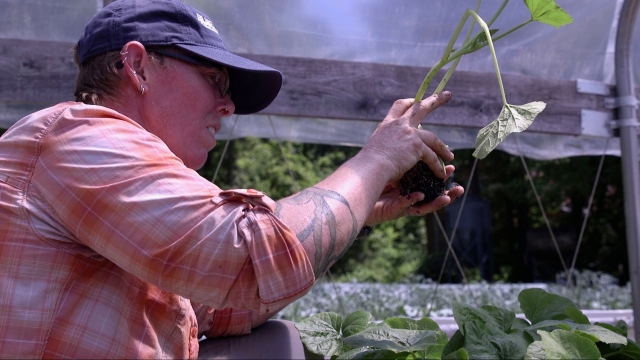For farmers, the soil is everything.
"I can't afford to hurt my soils."
Liz Graznak is the owner of Happy Hollow Farm — a 10-acre, USDA-certified organic farm in the small village of Jamestown, Missouri. It’s one of only a few organic vegetable farms in the state.
"My farm, in general, is pretty small, like the amount of ground that I'm growing in is pretty small. So we ask a lot of our soils," Graznak said.
Cover crops are used to protect and improve soil health. They're plants, like red clover, that are meant to cover the ground, not to be harvested. They slow runoff, which can both reduce the loss of topsoil due to erosion, and increase soil nutrients.
"Where I am farming right here, there's some significant clay in the soils and the cover crops have helped a lot," Graznak said.
But because space is limited, planting cover crops isn't always an option — so she turns to compost, which is more expensive.
"In order for me to pay my bills, I have to grow this amount of produce," Graznak said. "So we put them in where we can."
Although cover crops are becoming more common, less than 10 percent of all the cropland in the U.S. has them.
"We're seeing more big companies, even food companies like General Mills or clothing companies like Wrangler, that are encouraging farmers to use cover crops, which has been a big change in the last few years," University of Missouri Center for Regenerative Agriculture Director Rob Myers said.
Agriculture has been seeing the impacts of climate change for years. Experts say cover crops can help fight climate change because they capture carbon from the atmosphere.
"If we have well-established cover crops, then the cover crops can withstand intense rainstorms because the rainstorm is going to cause what? Is going to cause a lot of erosion," Humberto Blanco, an agronomy and horticulture professor at the University of Nebraska-Lincoln, said. "So it can mitigate that, the effects of climate change."
But in places like Nebraska, where Professor Blanco is from, there's not enough water to farm cover crops, meanwhile, other parts of the country are dealing with too much rain.
"The extremes in the weather are just becoming more extreme," Graznak said.
In Missouri, where Liz Graznak lives, it’s been raining a lot this year.
“Usually these would be planted outside," Graznak said. "But we haven't been able to plant them outside. And so we just got really behind because of the rain. If
I didn't have these high tunnels, we would be in big trouble. I have fields out here on the other side of these high tunnels that literally I haven't been able to get a tractor in for two months. Just been way too wet. You cannot work ground when it's wet, you damage the soil so badly. And I'm not saying that farmers don't do that. They do, but I'm not going to."
Stephanie Sandoval with Newsy first reported this story.



